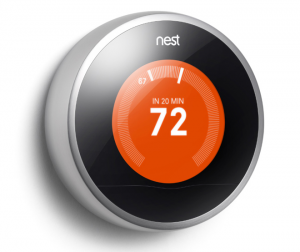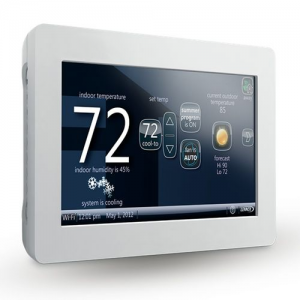 For every degree you lower your thermostat over an 8 to12 hour span, you can save between 1 and 3 % on your energy bill each year. When you add this up over several years, the dollars become more significant than you might first think. So proactively managing your thermostat or even getting into the habit of turning it down when you are not at home or at home and asleep may result in pretty significant savings over the long run.
For every degree you lower your thermostat over an 8 to12 hour span, you can save between 1 and 3 % on your energy bill each year. When you add this up over several years, the dollars become more significant than you might first think. So proactively managing your thermostat or even getting into the habit of turning it down when you are not at home or at home and asleep may result in pretty significant savings over the long run.
Although turning you heater off seems self-evident when you are not at home, you can dramatically save when you’re home as well! At night for one, when you’re already under the covers, consider setting your thermostat to 60 or below. Throw an extra blanket or two on the bed, and you will see that your body will not know the difference between 72 or 62, but your wallet will. Consider also an electric blanket. They are an inexpensive investment and will keep you toasty all night long preventing you from heating the entire house while you are under the covers in one room.
But the potential savings are not limited to the night. During the day, if you are at home, you can always don a sweater or additional layer of clothing in order to shave a degree or two on the thermostat. Clearly I am not advocating that you be uncomfortably cold, that somewhat defeats the whole purpose of having a comfort system to begin with, but lowering your temperature settings by a few degrees can make a material difference over time to your monthly expenses.
The point is, heating during the winter months (especially in LA’s generally milder climate), does have to, nor should it break the bank.
If pro-actively managing the thermostat in your home is simply too burdensome, (when we’re heading out the door in a rush, one may forget to adjust the thermostat, most of us would) a programmable one can take the thinking out of your hands, and put money back into our pocket. A programmable digital thermostat on new systems is a given, but on older furnaces it is often one of my frequently recommend solutions to save money. Your heating and cooling system may be old, but still fully functional, yet you may have an antiquated comfort control system. Installing a programmable thermostat is an inexpensive solution that will pay for itself MANY TIMES OVER in a short period of time.
But thermostats are just one part of the overall energy management equation. Most homes in the Los Angeles market are not particularly well-insulated, nor well suited for extreme temperature shifts. The benefit of a very mild climate has never necessitated the need for “bunker like” construction and insulation typical in the Midwest or the North East of the United States. As such, older homes especially in Los Angeles and especially the San Fernando Valley, are very thermodynamically porous. In other words heat from outside easily seeps in and furnace warmed air from inside easily escapes out. This can be expensive both in the winter (heating your living space) and in the summer (cooling your living space).
One of the first things to check are your windows and doors. Are they winterized? Are your doors and windows properly sealed? Is there weather stripping? Is the weather stripping old? Place your hand on the bottom of the threshold of your front door, kitchen or patio doors and see if you can feel a cool breeze seeping in. In many older homes you probably will. This means it’s time to either replace old dried up and compressed weather stripping or to a actually apply it (you may discover that there actually is NO weather stripping at all!)
If you feel air coming in along the seams of your windows in a windy and cool day… again a sign of bad window insulation. If replacing windows is not an option, consider some plastic film from the hardware store. It can keep warm air from escaping out your windows. Also make sure that there is weather stripping where it belongs.
Finally fill in any cracks in doors, windows, basements or attics with some caulk or silicone. Inspect the weather stripping at all doors leading to the outside and replace where damaged. This is a cheap and easy way to prevent your warm air from leaking outside. Also consider insulating your attic entry with plastic, blankets. Any little bit will keep warm air from going out of your house.
If you spend the majority of time in one room of your house (watching TV in the family room, in the kitchen or the bedroom) and are not using the rest of the house consider the option of a space heater. It’s not my favorite solution or one that I enthusiastically recommend, but with proper attention and safety precautions they can be used as an extremely economical alternative if budgets are tight and you can’t install ZONE CONTROLS, which are truly the professional way to address the problem of unnecessarily heating rooms nobody uses.
Although not as safe or ideal as ZONE CONTROL systems that enable you to only heat or cool certain rooms from your central comfort system, this economical approach will allow you to keep the temperature in the rest of the house cooler, resulting in significant savings for you. IMPORTANT SAFETY NOTE: Be sure space heaters are on hard and level surfaces only (NOT ON CARPETS OR CARPETING… and make sure they cannot fall over due to pets or precarious positioning… this is how fires start). Keep all flammable objects away from the heater and be sure children’s fingers cannot reach the heating element.
If you have spaces in your home that are commonly not used on a regular basis, like a spare bedroom, you may be inclined to consider closing off the vents in those spaces, as well as the doors. This is not something I generally recommend. You need to be careful of how many vents you close in your house as you could create an imbalance in your air circulation system. You do NOT want to do this on more than a couple of vents, even though you may think this is an effective method to cutting down on your heating.
Generally speaking, be sure vents are free of obstructions so the warm air can freely flow (furniture, drapery etc.) Open your blinds during the day to let the warm sunlight in, and close them at night to trap heat in.
Keep your fireplace damper closed! This seems like a NO BRAINER, but most people in LA keep them open year round. An open damper is like having a hole in your roof.
And if you really want to rack up the energy savings, consider replacing your current appliances with more energy efficient ones. While it is not cheap to replace all appliances at once, consider replacing them over time as your current appliances begin to break down. And don’t forget to check with your utility company to see if they offer rebates or discounts for installing energy-efficient appliances. In Los Angels they often do.
Speaking of appliances… after you’ve used your oven (and it’s shut off), leave the door open a crack. There’s a lot of heat in there that can warm up the kitchen, requiring your furnace to work a little less.
By using even just a few of these tips, you and your family can stay warm more economically through the winter months in Southern California.
